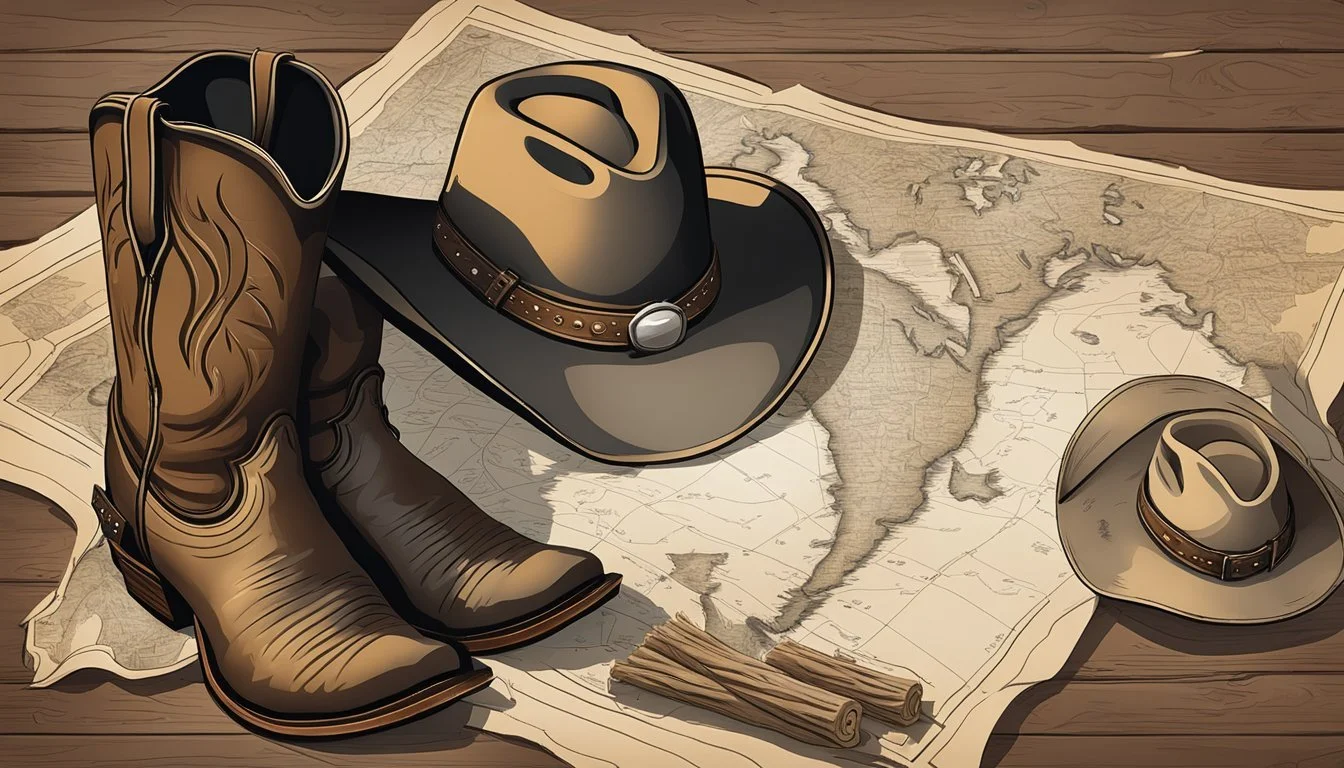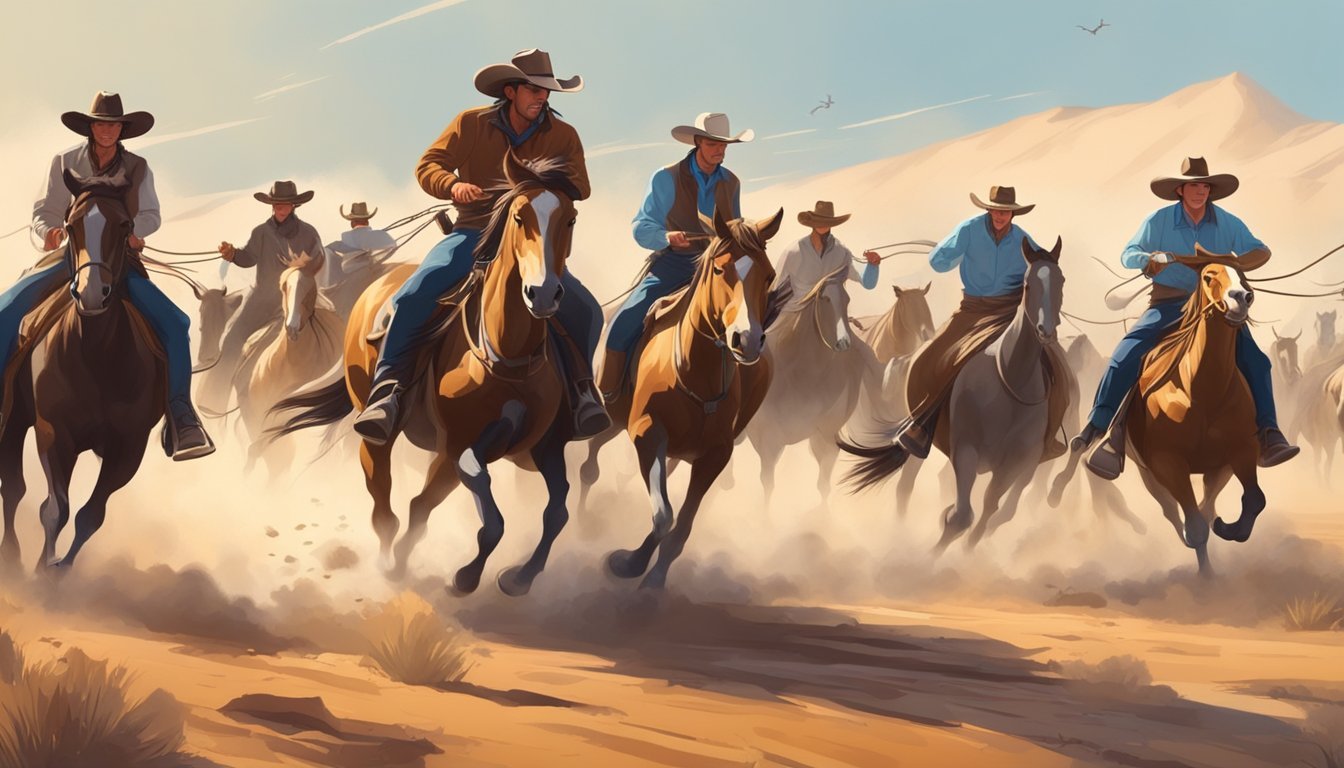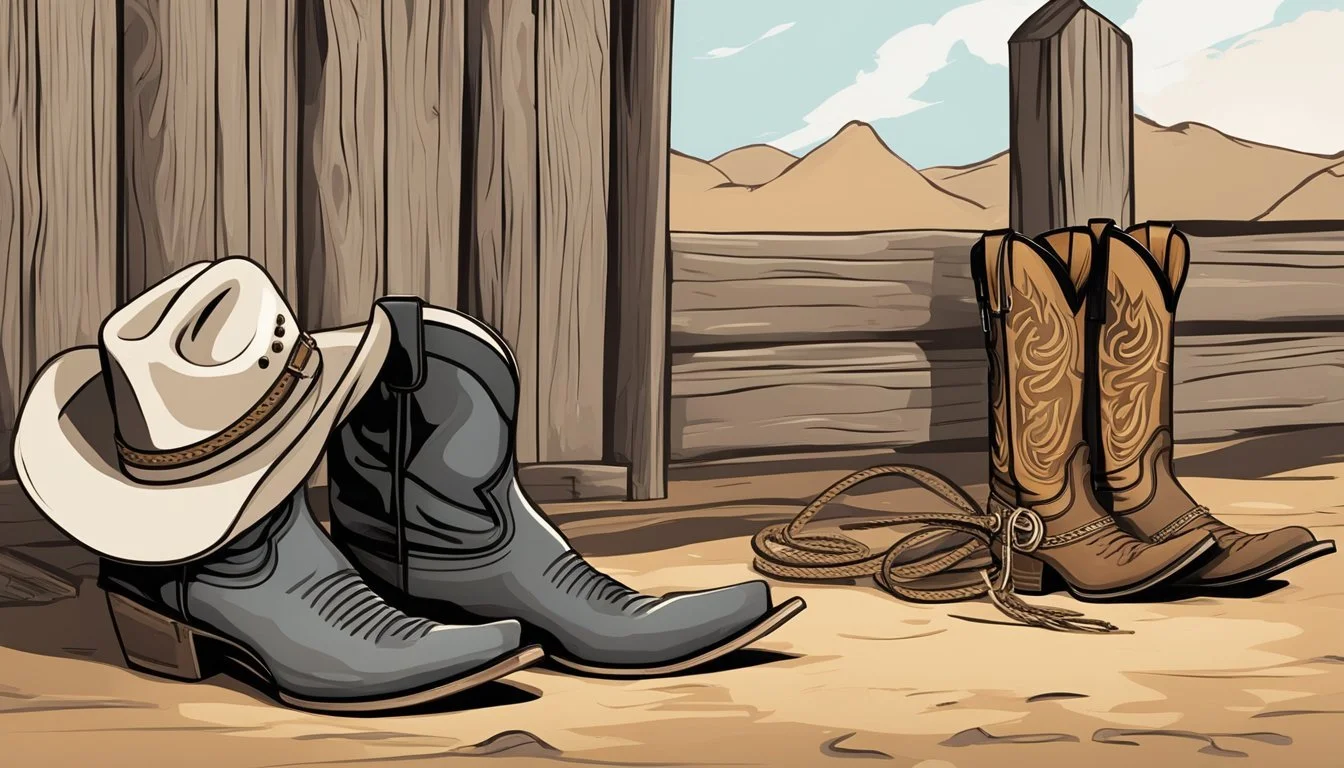The Impact of Cowboys on American Language and Slang
Tracing Linguistic Influence
The American cowboy, a symbol deeply entrenched in the nation's cultural imagination, has long been a source of fascination and myth-making. The imagery of the lone ranger, riding the ranges of the West, has left a significant mark on American language and slang. Beyond the romanticized figure, the practical and gritty lifestyle of cowboys in the Old West gave rise to a plethora of terms and phrases that permeated everyday language, some of which are still in use today.
These terms and expressions, born out of necessity and the unique experiences of the frontier life, reflect the ingenuity and adaptability of those who herded cattle across the vast American landscapes. As cowboys confronted the elements, interacted with diverse groups of people, and developed their own code of conduct, their vernacular became as distinct as their leather boots and Stetson hats. The linguistic legacy of the cowboy era provides insight into the values and attitudes of the time, illustrating how language evolves with culture.
Understanding the impact cowboys have had on American English is not just an exercise in historical curiosity. It's a key to decoding the etymology of modern expressions and grasping the essence of the American spirit, which cherishes freedom, individualism, and a deep connection to the land. As scholars and enthusiasts delve into the narratives of the American West, they reveal the extent to which cowboy slang has influenced idiomatic expressions and contributed to the colorful tapestry of American speech.
Origins of American Cowboy Language
The sprawling ranches and the cattle drives of post-Civil War America brewed a unique linguistic niche. Within this cultural melting pot, terms and expressions originated that continue to pepper the English language today.
Spanish Influence on Cowboy Slang
The impact of Spanish language on cowboy vernacular is profound, stemming from the vaqueros of Mexico who were skilled horsemen. The term "cowboy" itself likely evolved as a translation of "vaquero," meaning "cow herder" in Spanish. Post the annexation of large swathes of Mexican territory, including Texas and California, this influence permeated deeper. Rodeo, lasso, bronco, and stampede are all English adaptations of Spanish words introduced by the vaqueros and integrated into American cowboy speak.
Rodeo from rodear (to encircle or roundup)
Lasso from lazo (a tie or rope)
Bronco meaning "rough" (used for untamed horses)
Stampede from estampida (a flight or escape)
Native American Contributions
The integration of Native American terms into cowboy language underscores the cultural exchange on the frontiers. Native Americans provided insight into the landscape, wildlife, and other essential survival skills which cowboys adapted into their own jargon. For example, terms for local flora and fauna or names for places often have Native American origins. The influence extended to navigational terms and methods of tracking which became essential for the cowboys' cross-country cattle drives.
Adoption from Cowboy Professions
Cowboy professions within ranches and on the trail gave rise to a specific lexicon. Jobs like the wrangler, responsible for the care of horses, and designated terms such as "roundup" for the gathering of cattle, are foundational to the cowboy lexicon. Skills and tools necessary for cattle herding, horseback riding, and ranch maintenance influenced the creation of words. The Civil War era's demand for cattle in the North amplified this need, as droves of American cowboys from Texas to California drove herds over long distances, thereby spreading their specialized language and merging it with local dialects.
Wrangler—an individual specializing in horse care
Roundup—the process of gathering livestock
The melding of different cultures and languages, including English, Spanish, and those of Native American tribes, coupled with the specific requirements of cattle herding and ranching life, gave birth to the colorful jargon of the American cowboy—a legacy still felt in contemporary American English.
Rodeo Terminology
The infusion of cowboy culture into the American lexicon is particularly evident in terms commonly used within the context of rodeos and ranch activities. These terms paint a vivid picture of life on the open range and the dynamic between cowboys, livestock, and the rituals of ranch life.
Rodeo and Ranch Events
Rodeo events have brought forth a bevy of terms that define the unique contests and skills displayed by cowboys. Rodeos, for instance, are not just exhibitions of riding and roping; they are arenas where heritage is showcased and linguistic traditions are passed down. During these events, cowboys clad in boots and hats compete in activities akin to the tasks of historic cattle drives. Events such as the saddle bronc riding, a test of maintaining balance on a bucking horse, exemplifies the agility and courage that were essential for managing cattle on horseback.
Cattle roping pays homage to the necessary skill of catching cattle on the open range using a lasso. Wranglers were experts at this task and competed in timed events to showcase their precision and speed. The dance after a rodeo often celebrates the camaraderie and shared experiences of the ranching community.
Event Name Description Saddle Bronc Rider must stay on a bucking horse while holding onto a saddle. Bull Riding Cowboy aims to stay mounted on a bucking bull for eight seconds. Calf Roping Cowboy ropes a calf as quickly as possible then ties its legs. Barrel Racing Rider guides horse to complete a cloverleaf pattern around barrels.
Horse and Livestock Terms
The intimate relationship between cowboys and their horses and cattle spawned an evocative set of terms that describe the temperaments and traits of these animals. A Bronc, short for bronco, refers to a horse that could be untamed and challenging to ride. The term has Spanish origins, reflecting the influence of vaquero culture on American ranching. Conversely, terms like Bufford suggest a more cooperative animal that's easier to ride or handle.
Livestock, particularly cattle like the iconic longhorn, are central to cowboy vernacular as well. Terms related to livestock management are omnipresent, such as branding, which is both a practical means of marking ownership and a symbol of cowboy ritual. Cowboys on horseback, often referred to as buckaroos in certain regions, exhibit a deep connection to their livestock, treating them with a level of respect that denotes their reliance on these animals for their livelihood.
Term Meaning Bronc A horse, often unbroken, that offers a challenging ride. Bufford An animal that's cooperative in rodeo or ranch activities. Longhorn A breed of cattle identified by its characteristic long horns. Branding The act of marking cattle for identification.
These sections of rodeo terminology provide insight into the influence cowboys have had on American speech and highlight the significance of rodeo culture.
Ranching and Cattle Handling
In the evolution of cowboy culture, language played a pivotal role, particularly within the contexts of ranching and cattle handling, where distinct vocabularies and slang terms developed.
Ranch Work Vocabulary
The day-to-day ranch work was punctuated by a vocabulary specific to the tasks and tools at hand. Cowhands, dressed in chaps, would saddle their horses, often mustangs, for a day of hard work. A typical ranch in states like Colorado, Arizona, or Kansas had a bunkhouse for the cowboys to live in, a lariat, and spurs as essential equipment. Specific terms include:
Chaps: Protective clothing to guard the cowboy's legs against the rough brush.
Lariat: A rope used for lassoing cattle, crafted from braided leather or other materials.
Hackamore: A type of headgear for a horse, allowing more control than a simple halter, used before a bit is introduced.
A rancher's vocabulary extended to the horse tack that facilitated their work. Being knowledgeable in this vernacular was as important as the riding and herding skills themselves.
Cattle Drive Slang
During a cattle drive, cowboys developed their own slang to communicate efficiently and manage the livestock:
Desperado: A reckless or desperate outlaw, often a fugitive from the law.
Mustang: A free-roaming horse of the American west that descended from horses brought by the Spaniards.
Rancher: An individual who manages or owns a ranch.
A cowboy's dialect was peppered with such terms, with every piece of vernacular serving a practical purpose. These languages cultivated within the context of cattle drives helped shape identifiable aspects of cowboy culture.
Lists of commonly used cattle drive slang terms included in this environment:
Boss of the plains: A western-style hat that kept the sun off a cowboy's face.
Lasso: A loop of rope designed to be thrown around a target and tightened when pulled.
In these endeavors, it was imperative for cowboys and cowhands alike to be adept with a lasso, handle a rowdy herd, and take directives from ranchers who oversaw the operation. Practicality in language paralleled the practicality of their daily duties.
Cowboy Life and Culture
Cowboy life was a blend of practical skills, unique attire, and a social structure that revolved around the demanding tasks of ranch life. Their culture greatly influenced American language and slang, leaving an indelible imprint on the modern lexicon.
Attire and Gear
Cowboy attire was as functional as it was iconic. Cowboys typically wore wide-brimmed hats for protection against the sun, boots with high heels to prevent slipping from stirrups, and chaps to shield their legs from thorny brush. The essential cowboy saddle, designed for hours of riding on the ranch, was crucial for day-to-day operations.
Cowboy Gear Purpose Wide-brimmed hats Sun protection Boots Footing in stirrups, snakebite protection Chaps Leg protection from terrain, brush Saddle Comfort and utility for long hours of horseback riding
Cowboy Social Life
The social life of cowboys centered around the ranch where they worked. Many cowboys were young men referred to as wranglers, caring for the horses and cattle. After a long day, they returned to the communal bunkhouse, where stories and slang – words like tenderfoot for a novice, or hoosegow for jail – filled the room. Rodeos and cowboy dances provided rare but awaited communal entertainment.
Influence on Modern Culture
Cowboys have left a significant mark on modern culture, particularly in film and language. Famous cowboys like Gene Autry brought the cowboy aura into the entertainment industry. Their slang and sayings still color today's conversations, and elements of cowboy dress remain fashion staples. The image of the cowboy, riding a mustang with a lasso at the ready, embodies personal freedom and resilience in American culture.
Language Evolution and Legacy
The rich lexicon of cowboy slang has left a lasting imprint on the American English language, reflecting its endurance through time. From the dusty trails of Texas to the high plains of Colorado, the echoes of cowboy speech patterns continue to resonate in contemporary dialogue.
Cowboy Slang in Modern Times
Cowboy culture has bequeathed a colorful array of sayings and slang to modern American English. Expressions originating from the cattle ranching lives of cowboys in states such as Texas, Arizona, and Colorado have evolved but still hold their core meanings. For instance:
"Bite the dust"—originally meant falling off a horse, now used to describe failure or defeat.
"Kick up your heels"—once a way to describe a horse's behavior, today it means to celebrate or enjoy oneself.
This linguistic heritage showcases the vibrant evolution of language within daily communication and highlights the cultural significance of the American cowboy.
Preservation of Cowboy Language
Efforts to preserve the unique terminology of the American cowboy are evident in various aspects of contemporary society. Schools and historical societies, especially within the regions where cowboy culture thrived, contribute to conserving this historical vernacular. For example:
State Preservation Effort Texas Cowboy poetry gatherings and rodeo events Arizona Western film festivals and heritage tours Colorado Museum exhibitions and educational programs
These initiatives serve not only as a remembrance of the past but also as a way to maintain the essence of cowboy language for future generations. They document the way in which this occupational jargon has become an integral part of the identity of the American West.
Slang and Sayings Encyclopedia
The language of the American West is a testament to the rugged life and eclectic mix of cultures that thrived during the era of cowboys. This section dives into the wealth of sayings and slang terms that have enlivened American English, many of which are still in use today.
Comprehensive List of Cowboy Sayings
Ace in the Hole: A hidden advantage or resource.
Acknowledge the Corn: To admit the truth or to confess a lie.
A Lick and a Promise: To do something in a hasty and superficial manner.
All Down But Nine: Missed the mark, not up to par.
At Sea: To be confused or not understanding.
Ace-High: First-rate, respected.
Adam’s Ale: Water.
Addle-Headed: Confused or foolish.
Afterclaps: Unexpected events following the main event.
Airish: A little cool.
Alfalfa Desperado: A pretend cowboy, all show and no substance.
Expressions and Their Meanings
Above Snakes: If someone was "above snakes," they were still alive.
"Billy is above snakes, so stop your worrying."
Actual: Genuine, real.
"That horse is the actual best in the county."
Apple Pie Order: Neat and tidy.
"Make sure the gear is in apple pie order before the trail ride tomorrow."
Across Lots: Taking a shortcut.
"Let's go across lots to reach the ranch faster."
Acorn Calf: A very young, inexperienced person.
"He's just an acorn calf; he’ll learn the ropes soon enough."
Afeared: Afraid.
"She ain't afeared of any mustang, no matter how wild."
A Hog-Killin' Time: A really good time.
"The dance at the barn was a hog-killin' time!"
Airin’ the Lungs: Talking a lot or loudly.
"After the dispute, he’s sure been airin’ the lungs."
Ambush: To attack from a hidden position.
"Keep your eyes peeled, boys. There might be an ambush waiting for us in the canyon."
Among the Willows: Hiding or evading the law.
"The outlaw's been among the willows since the sheriff came lookin'."
These terms only scratch the surface, but they provide insight into how cowboys communicated and how their unique slang has influenced the modern American vernacular.






